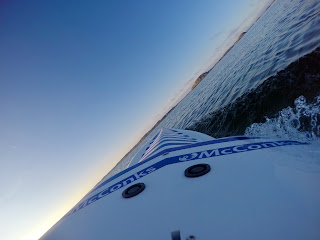Part 2 - Getting the Go Race 14c wet
The back story to the board, how it came to be can be found here, this post skips over the first part of the learning curve with a new board and gets to the details.
It’s still winter here in western Sweden, my local lakes have been ice free for a couple of weeks but air and water temps are still low, below zero in the mornings when I paddle most. Paddling is still in a drysuit and thick boots which are not ideal when trying to paddle faster. Since the board arrived I’ve managed nearly 200km in mixed conditions from glass to very windy and here’s what I’ve learned …
Above the water
Starting from the front I wanted the board to be pretty flat and it is. I left the amount of rocker to Andy, he has far more experience with specifying rocker than I do and he’s got that right for the paddling I do.
The shape of the bow works exactly as I had envisioned, my only observation is that it could have been a little sharper but as it is there is very disturbance in the water at the bow with a very smooth flow over and around the board. Even when starting a sprint the bow just pushes though the water efficiently with no fuss. A huge improvement from the Carbon Sport!
The deflector that Andy incorporated in the design is the stand out visual feature of the board, there is nothing else quite like it and it does divide opinion. In chop and larger waves where water comes over the front half of the board it works perfectly, no water has got as far as the dugout and I’ve have the nose pretty much submerged a few times.
The dugout works well. Drainage could not be better and the gutters Andy put in at the sides of the standing area do a very good job of moving water away from the feet when water has got in. So far this has only been from waves coming over the sides and from a few swims… Those swims have also been good test for getting back onto/into the board.
On the top of the board the chevron paint job is lovely, the finish from Prestol was perfect. The deck grip is grippy and comfortable under wetsuit boots, the handle has just the right amount of paddling and is absolutely perfectly positioned, the board is flat when being carried. The middle leash point in my wish list moved to the stern but will move back to the middle of the board in production leaving one at the tail and one more at the front of the standing area. The position of the forward GoPro mount will be tweaked a little and there may be a small change to the graphics but noting else needs changing.
My only modification to the board has been is to add a pair of stick-on mounts for a cargo bungee at the front of the dugout. There is more than enough space there to easily hold a decent size dry bag in place and drinks bottles. This adds to the versatility of the board, maybe not enough for a multi day trip but certainly more than enough for a long day on the water.
Under the water
The board is 24 inches wide at its widest point, this is at the waterline in the middle. Under the waterline the sides tuck in giving a width of 19 inches on the bottom of the board. This is a little less than my wish-list specification! Bringing the sides in under the water was Andy’s idea and it works, even though when I saw the hull in the flesh I was concerned, unnecessarily so. The boards secondary stability is amazing and this is the main reason I’ve not been swimming more often.
No fin was supplied with the board so I’ve been trying a few different fins. So far I have found that the McConks Carbon Cutout fin is a very, very good match for the board in all conditions while a touring fin just feels wrong and we won’t talk about using a flexi river fin in a carbon race board. Needless to say that a full size US fin box gives a massive range of fins to chose from. To get my favourite FCSII fins in I had to sand away a little bit of paint from the side of the fin box.
Performance
It took a little while to get used to the board, she is much narrower and therefore more wobbly than any other board I have owned. Once moving and when I start to relax she has been far better behaved than anticipated, there have been plenty of 'oooooooohhhh' moments but swimming has been a rare event.
I am glad to say she’s fast, faster than expected given the conditions here, did I mention that already. My average speed when ‘training’ is comfortably higher than I was achieving on the Carbon Sport in warmer water and I exceeded my expectations in my first event of the year, the second event in the UK Time Trial series hosted by Haywood Sports at the end of March. I had set myself a target of 36 minutes for the 5km event and was pretty happy to post a time of 35 minutes 33 seconds, averaging 8.4 km/h on a windy day despite having to modify my planned route mid event due to ice blocking my path. There is much more to come when things warm up here.
What’s next?
For me I’m considering selling one of my other 14’ hardboards because this one has proved to be more versatile than ‘just’ a race board. For McConks a decision will need to be taken on a production run, let Andy at McConks know if you want a fast board!





